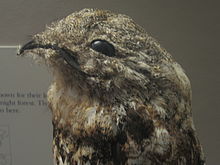- Great Potoo
-
Great Potoo 
Great Potoo
 Birdsong (help·info)
Birdsong (help·info)Conservation status Scientific classification Kingdom: Animalia Phylum: Chordata Class: Aves (unranked): Cypselomorphae Order: Caprimulgiformes Family: Nyctibiidae Genus: Nyctibius Species: N. grandis Binomial name Nyctibius grandis
(Gmelin, 1789)The Great Potoo (Nyctibius grandis) is a bird, both the largest potoo species and the largest member of the order Caprimulgiformes (nightjars and allies). It occurs in tropical America.
Contents
Description
Though related to the nightjars, like other potoos it lacks the bristles around the mouth found in the true nightjars (Caprimulgidae). Larger than a crow at 48–60 cm (19-24 inches) long and 360-650 grams (12.7 oz-1.4 lb), this potoo's size is distinctive when seen. It is pale greyish to brown, finely patterned with black and buff. It has large orange eyes. The overall appearance is pale and grayish. The underside is barred and vermiculated, including the buffy chest. The tail is barred with sharply defined black borders, while the head and back are mottled with gray and buff. Like most members of their order, the Great Potoo has plumage that is well-suited for camouflage.
The song is described as deep, guttural, strangled cries like borrrrrr or oorrroo repeated after a consistent interval of 10 to 20 seconds. The most common call is a loud, startling bark, BWOW! or GWOK! This call is usually made while the bird is disturbed.
Range and ecology
It ranges from southern Mexico through northeastern Guatemala and through most of Central America down through South America as far as Bolivia and southeastern Brazil.
The Great Potoo is found mostly in dense lowland forest, forest edges and clearings. It may also range into foothills (up to about 1,500 m elevation), second-growth, open woodlands (including plantations) and is sometimes seen around meadows, but they always require trees-etc., for their camouflaged imitative perch.
This nocturnal predator is usually seen perched high above the ground while forgaging, sallying out when prey is spotted. After the pounce, the potoo almost always returns to its previous perch. The prey consists mostly of large flying insects, especially large beetles, katydids and Orthoptera. Bats are also taken. Normally, during the day it perches upright on a tree stump, and is overlooked because it resembles part of the stump; this is a camouflage, not just by coloration, but a camouflage by the setting. The Great Potoo can be located at night by the reflection of light from its eyes as it sits vertical on a post, roost, or angled-tree trunk.
Breeding has been recorded as typically February to August, but depending on the portion of this bird's range breeding birds can be met with almost year-round.[1] The nest is a slight depression on a thick tree branch,[2] at least 10 m (33 ft) above ground, with a single white (slightly spotted) egg measuring about 5.2 x 3.8 cm (2 x 1.8 inches). Few details are known of the brooding behavior, but about a month elapses before the offspring is seen alone at the nest. After about 5 weeks the nestling is a two-thirds version of the adult, but with a lighter build, paler plumage, shorter tail, and smaller bill with less rectal bristles. The fledging period must be at least 2 months.
The Great Potoo is normally described as "uncommon", but occurs frequently in areas of less disturbed forests and is often found to be rare along the edges of its range. The clearing of forest is the only conservation threat known to this bird. Due to its large range, it is considered a Species of Least Concern by the IUCN.
Footnotes
- ^ E.g. an attended nest at Tiputini Biodiversity Station, Ecuador, in late December 1999 (Cisneros-Heredia 2006).
- ^ E.g. Ceiba sp. (Cisneros-Heredia 2006)
References
- "Nyctibius grandis". IUCN Red List of Threatened Species. Version 2007. International Union for Conservation of Nature. 2004. http://www.iucnredlist.org/apps/redlist/details/48625. Retrieved 23 September 2007.
- Cisneros-Heredia, Diego F. (2006): Notes on breeding, behaviour and distribution of some birds in Ecuador. Bull. B.O.C. 126(2): 153-164.
- Holyoak, D.T. (2001): Nightjars and their Allies: the Caprimulgiformes. Oxford University Press, Oxford, New York. ISBN 0-19-854987-3
External links
- Great Potoo videos on the Internet Bird Collection
- Stamps (for Suriname) with RangeMap
- Photo-Medium Res; Article home.scarlet.be–"Northern Venezuela"
- Great Potoo photo gallery VIREO (with camouflaged perching)
Categories:- IUCN Red List least concern species
- Nyctibius
- Birds of Central America
- Birds of South America
- Birds of the Amazon Basin
- Birds of Mexico
- Birds of Guatemala
- Birds of Bolivia
- Birds of Brazil
Wikimedia Foundation. 2010.


